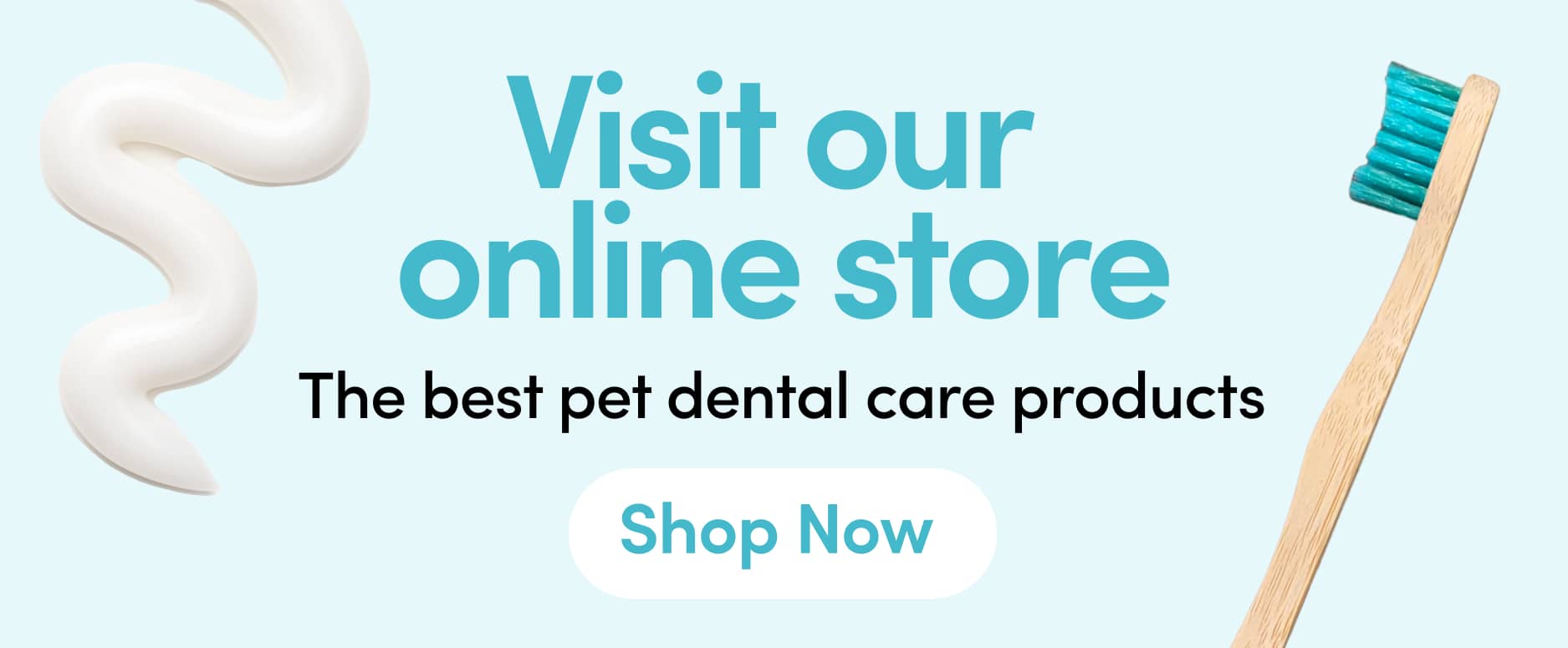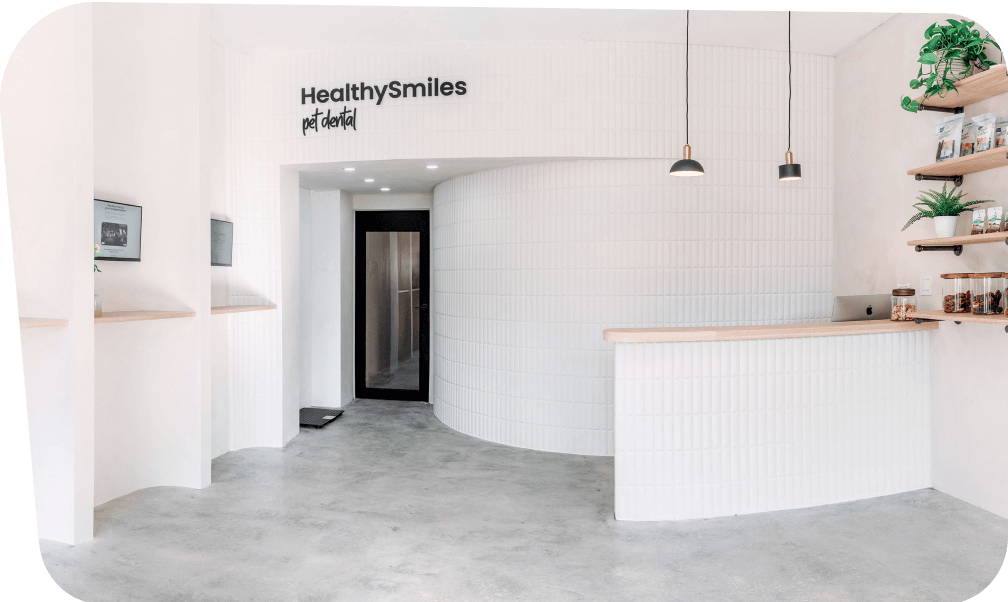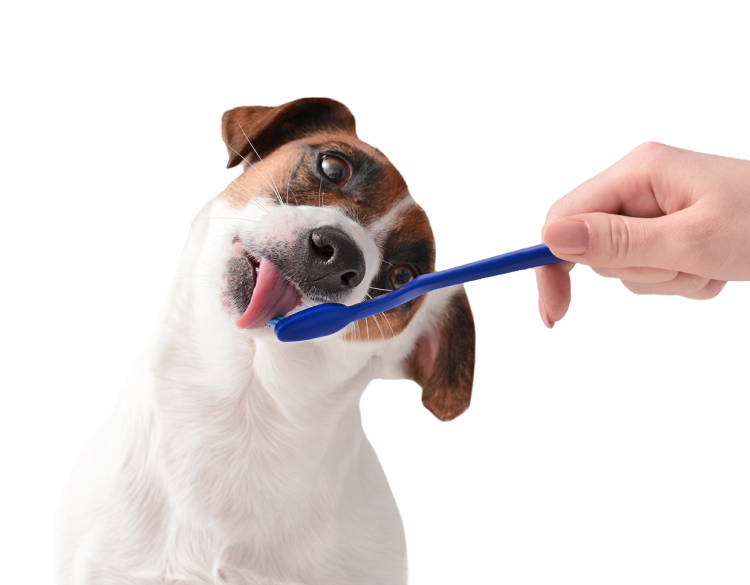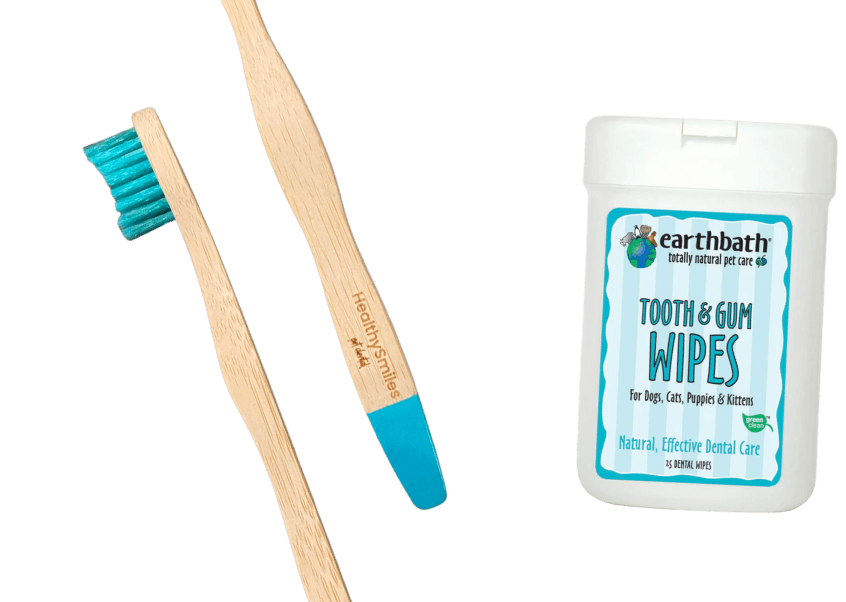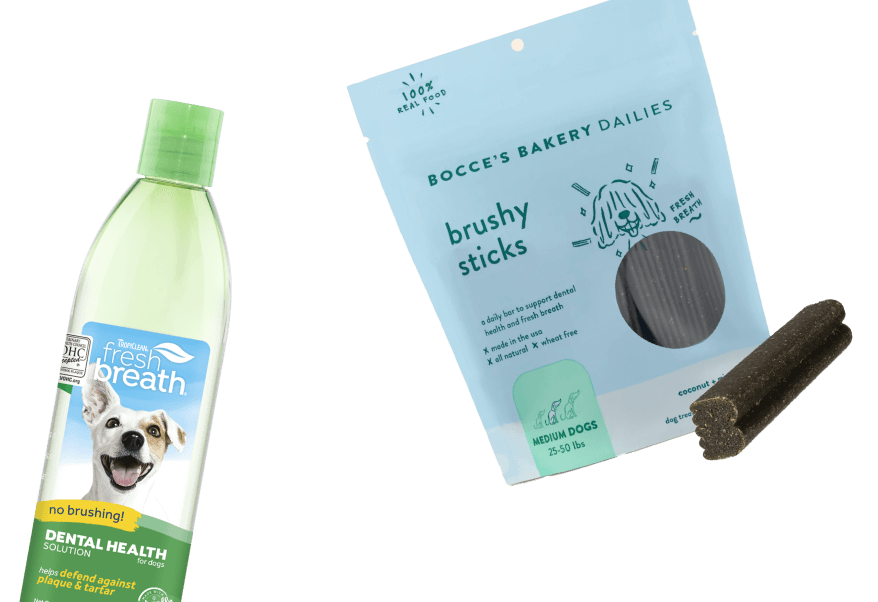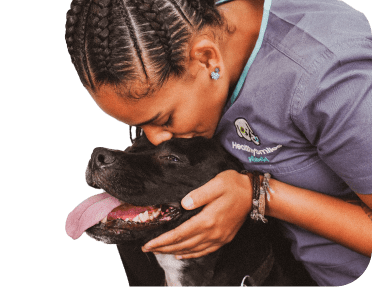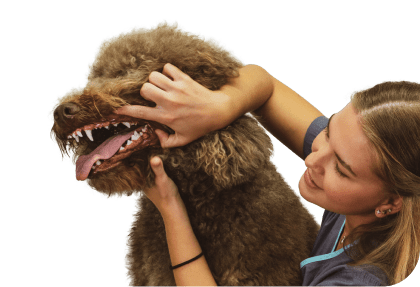Tips to Improve Your Dog’s Dental Health
March 2, 2022Dental care doesn’t differ much between species. But unlike humans, dogs cannot brush, floss, or rinse on their own. As your dogs’ companion and caretaker, you can help them maintain strong and healthy teeth for years to come. Keep reading to find out some useful dog dental health tips, plus how you can develop a solid oral hygiene routine for the companion canines in your life.
Periodontal Disease in Dogs
Just like people, dogs can develop periodontal disease. Simply put, it involves inflammation of the gums and bones that support and surround your dogs’ teeth. Gingivitis is among the earliest stages of bacteria from plaque and tartar buildup in their mouths. This inflammation could eventually lead to pain and bleeding gums if left untreated. You may recognize some common signs of dog gingivitis:
- Bad breath
- Staining, discoloration, or calcified spots on teeth
- Swelling, bleeding, or pus discharge from gums
- Drooling, loose teeth, or receding gums
- Difficulty eating or refusal to eat
How does gingivitis turn into full-blown periodontal disease? Well, the tartar and plaque buildup pushes the gums away from the normal gum line. They inadvertently expose more surface areas of your dogs’ teeth, leaving them open for even more food and bacteria to stick.
<Once the gums have receded, more bacteria, plaque, and tartar grow exponentially and cause infections. This can develop into periodontal disease with consequences such as tooth loss, weight loss, and irritability. There’s also a proven link between periodontitis and other serious conditions like heart disease, with bacteria from the mouth hitching a ride to your dogs’ arteries via their blood.
Dog Teeth Brushing Essentials
Before you start, you should remember one key thing about dog dental health: NEVER use human toothpaste on your canine friends. Thanks to the higher fluoride content and artificial sweeteners, human-grade toothpaste varieties can make dogs sick or even poison them. Baking soda isn’t a good idea either. With its high alkaline levels, it can upset your dogs’ stomachs and cause vomiting, diarrhea, and other negative effects.
Fortunately, there are many varieties of pet toothpaste on the market. Enzymatic formulas are the most popular — these can help break down plaque and bacteria before they can damage teeth. Pet toothpaste does not contain any foaming agents that can harm your furry friends. They’re also safe to swallow.
Some kinds of pet toothpaste are designed for both canines and felines (helpful if you also have cats in your household), but there are also dog-specific formulas. Some are flavored and taste like beef, poultry, or seafood.
Besides pet-formulated toothpaste, you’ll also need a toothbrush. Pet toothbrushes tend to be a little smaller than human versions and have softer bristles. You could also try a finger toothbrush, which fits over your index finger like a sleeve or thimble. If none of these are feasible, you can use a piece of cheesecloth wrapped around your finger with a small amount of dog toothpaste.
Good Brushing Technique
Proper brushing keeps your dogs’ teeth healthy and goes a long way to preventing periodontal disease. The idea of brushing will seem alien to them at first, and they may not feel comfortable with you touching their mouths. However, you can get them accustomed to the practice. You’ll want to choose a time when they’re calm and relaxed. It’s also wise to have your oral care tools ready in advance.
Before you begin, assess your dogs’ comfort level. Do not continue if they seem anxious or afraid. Also, don’t stand over them or hold them down. Instead, try sitting or kneeling in front of your dogs — you’ll be able to reach their mouths plus put them more at ease. To get them used to brush, gently rub along their teeth and gum lines. Keep in mind that you may need to do this for a few days before diving into full-on brushing.
You’ll also need to introduce your dogs to pet toothpaste. Start by putting a small amount of pet toothpaste on your finger and letting them taste it. After a few days of this, you can start actually brushing their teeth with your pet toothbrush and toothpaste. If they reject the toothpaste you’ve chosen, try another variety.
Starting when they’re young is key, but even older dogs can benefit. Brush once daily, and be sure to remove excess food from their teeth as you go. Avoid excess pressure, as this can trigger a large amount of bleeding. Keep the mood lighthearted and reassuring during each brushing session. Don’t forget to praise your dogs while you’re brushing their teeth. Be sure to reward them with positive reinforcement after each time you brush.
Tip 1: Brush Your Dog’s Teeth
Brushing your dogs’ teeth is similar to brushing your own. But you’ll need a slightly different approach. You can clean their teeth by using a simple procedure:
- Gingerly lift your dog’s upper lip.
- Angle the toothbrush’s bristles until they touch the gum line.
- Place the brush head at a 45-degree angle against the teeth.
- Brush in small circles from top to bottom.
Keep in mind that you may not be able to get the entire mouth on the first, second, or even third day. Work up to two minutes of brushing at first. If you’re struggling to get your dogs to handle brushing, don’t fret. Aim for the outsides of the canines and back teeth as your first priority.
Tip 2: Use an Oral Rinse for Dogs
An oral pet rinse works like mouthwash for humans — minus all the fluoride, sweeteners, and alcohol in human versions. You may see them labeled as “dental care water additives,” which can be mixed in with your dogs’ drinking water in small amounts. Some call themselves “oral health care solutions.” Others are oral rinses that you gentle squeeze on your dog’s gum line or apply gently by dabbing the teeth and gums with a tissue.
Most oral rinses for dogs are designed for daily use. When paired with brushing your pet’s teeth, they can help keep plaque buildup at bay. Whatever version you buy, be sure to read and follow the instructions carefully.
Tip 3: Give Your Dog Dental Health Treats
Dog dental health treats are a great addition to your canine companion’s dental routine. They’re specially formulated to reduce plaque-causing bacteria, activated by your dog’s crunching and chewing. As a side benefit, your dog builds up stronger jaw muscles in the process.
Dog dental treats come in many different forms: chews, crunchy bits, sticks, and the like. You’ll also find them in a wide range of sizes for small, medium, and large dogs, so make sure you pick the right size for your pet. Professionals recommend supervising whenever you give these treats to your dogs, just to make sure they’re OK with chewing them.
Finally, look at the label or product information of any kind of dental treats before you buy them. You’ll find products approved and endorsed by the Veterinary Oral Health Council — VOHC for short. The VOHC only endorses treats that prove to help pets’ teeth and gums. Look for the words “Veterinary Oral Health Council approved” on the label.
Tip 4: Pay Attention To What Your Dog Eats
Dogs can be notorious for putting anything in their mouths, including lots of things that can harm them. Sharp objects, rocks, debris, and even old shoes can fall victim to doggie chompers. And if the object is hard or has jagged edges, your dogs may end up with fractured teeth or injured gums. Keeping your yard and floors clear of debris, trash, and other risky stuff helps cut down on the chance of your dogs chowing down on things they shouldn’t.
Tip 5: Stick to Dry Dog Food
You already know that your dogs’ diet impacts their overall wellbeing, but it does also affect their dental health. Dry dog food can help remove some tartar that may be present on their teeth. Crunchy dog food also doesn’t stick as readily as wet dog food, which can contribute to bacteria growth when it remains on their teeth. Talk to your vet before you switch foods. You can get some useful recommendations, including special dental diet formulas and varieties designed to meet senior dogs’ nutritional needs.
Bonus Tip: Create a Dog Teeth Cleaning Routine
We’ve already mentioned that dog dental health is a daily routine. Daily brushing is ideal, along with oral care rinses and dental treats. This is especially important for dogs requiring an exclusively wet food diet or smaller breeds such as Maltese dogs or Chihuahuas. Rome wasn’t built in a day, however. Building up slowly to daily oral care can make it a pleasant experience for your dogs. If they cannot tolerate daily brushing, aim for two to three times per week to clean their teeth and avoid a decline in their oral health.
Don’t Forget the Chew Toys!
Brushing, oral rinses, dental treats, and smart food choices are vital to supporting dog dental health. But did you know that certain dog toys can also make a difference? You’ve probably seen Kong toys, which are bubble-shaped and hollow in their centers. They’re perfect for dog toothpaste or dental treats in their centers.
Other options include rawhide bones, which encourage chewing but be sure to replace each rawhide bone when it’s gotten soft. You can also look for specially designed dental chew toys equipped with bristles and ridges that help take plaque and tartar away while your dogs chew on them.
Professional Teeth Cleaning for Pets
Your beloved pups can also benefit from regular teeth cleaning sessions. Most veterinarians give pets general anesthesia. However, innovations in pet healthcare have opened up professional teeth cleaning options that do not require anesthesia. These pros use a few techniques to help your pet during the process:
- Aroma and sound therapy
- CBD products to aid in relaxation
- Open concept environments
Aromatherapy and soothing sounds promote a calm setting for your dogs’ teeth cleanings. You can also opt for CBD, which contains natural compounds that reduce anxiety without any side effects. Open concept environments do not use cages, so pets feel more at ease. Often, the cleaning process goes faster without them.
Teeth cleaning sessions start with a short evaluation, during which a professional will check your pet’s tooth and gum health. This dental health specialist looks for issues such as bleeding gums and pockets where food can get stuck.
Next comes the teeth cleaning stage, plus polishing to take away plaque and tartar buildup. This includes tooth scaling, which is done with hand and ultrasonic scaler tools. Curettes reach beneath your dog’s gum line to safely clean in such delicate areas. Surface polishing eliminates stains and small scratches in your dog’s tooth enamel, but it also helps slow the rate of future plaque buildup. With a brief wiping to remove debris plus a gentle rinse, your pet’s teeth cleaning is done.
Smaller dogs can begin these professional teeth cleanings when they’re around two years old. Larger dogs’ needs may vary. No-anesthesia cleanings are safe and affordable, so your pet can benefit from twice-yearly cleanings every six months. They can also inhibit plaque and tartar damage more effectively than a single annual cleaning.
Dental Cleaning “Gone to the Dogs”? It’s Not Too Late!
Self-care for humans can seem challenging, so caring for your dog’s teeth can seem downright difficult. But no matter how old your dog is, you can keep your dog’s teeth in good condition with a home oral hygiene regimen. You can become skilled at brushing canine teeth with time and practice. Add the oral rinse and dental health treats we’ve already mentioned, and you have an excellent foundation for dog dental health.
Regular Professional Dog Teeth Cleanings in Florida
Thanks for reading our dog dental health tips! We hope you enjoyed this guide and gleaned a lot of helpful information. At HealthySmiles Pet Dental Spa, your pets’ dental health is our business — literally. With non-anesthesia relaxation methods, we’re changing the landscape of pet oral healthcare. And we do house calls! Book an appointment online at our pet dental spa in Plantation, Florida, or schedule a convenient house call.


